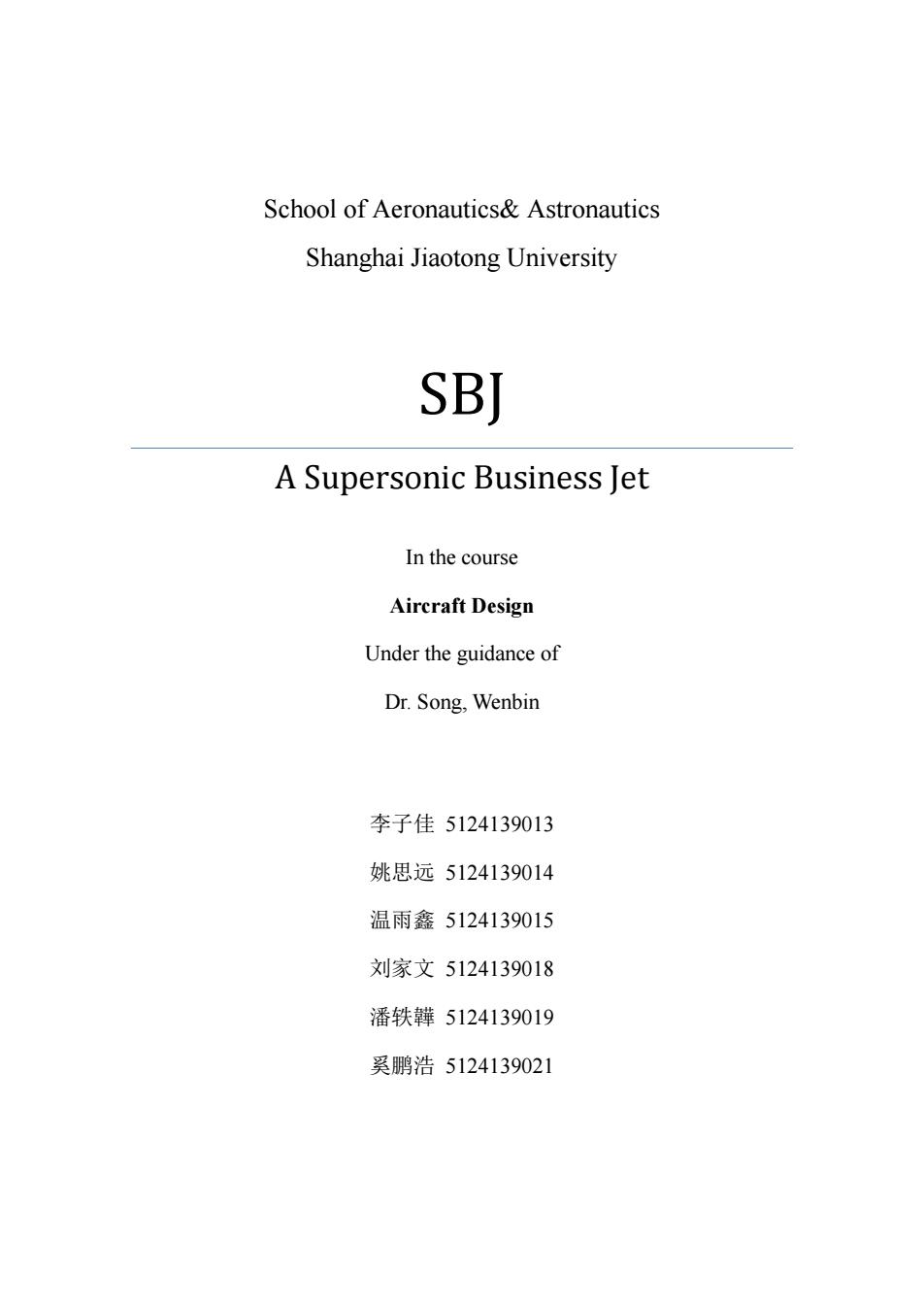
School of Aeronautics&Astronautics Shanghai Jiaotong University SBJ A Supersonic Business Jet In the course Aircraft Design Under the guidance of Dr.Song,Wenbin 李子佳5124139013 姚思远5124139014 温雨鑫5124139015 刘家文5124139018 潘轶韡5124139019 奚鹏浩5124139021
School of Aeronautics& Astronautics Shanghai Jiaotong University SBJ A Supersonic Business Jet In the course Aircraft Design Under the guidance of Dr. Song, Wenbin 李子佳 5124139013 姚思远 5124139014 温雨鑫 5124139015 刘家文 5124139018 潘轶韡 5124139019 奚鹏浩 5124139021
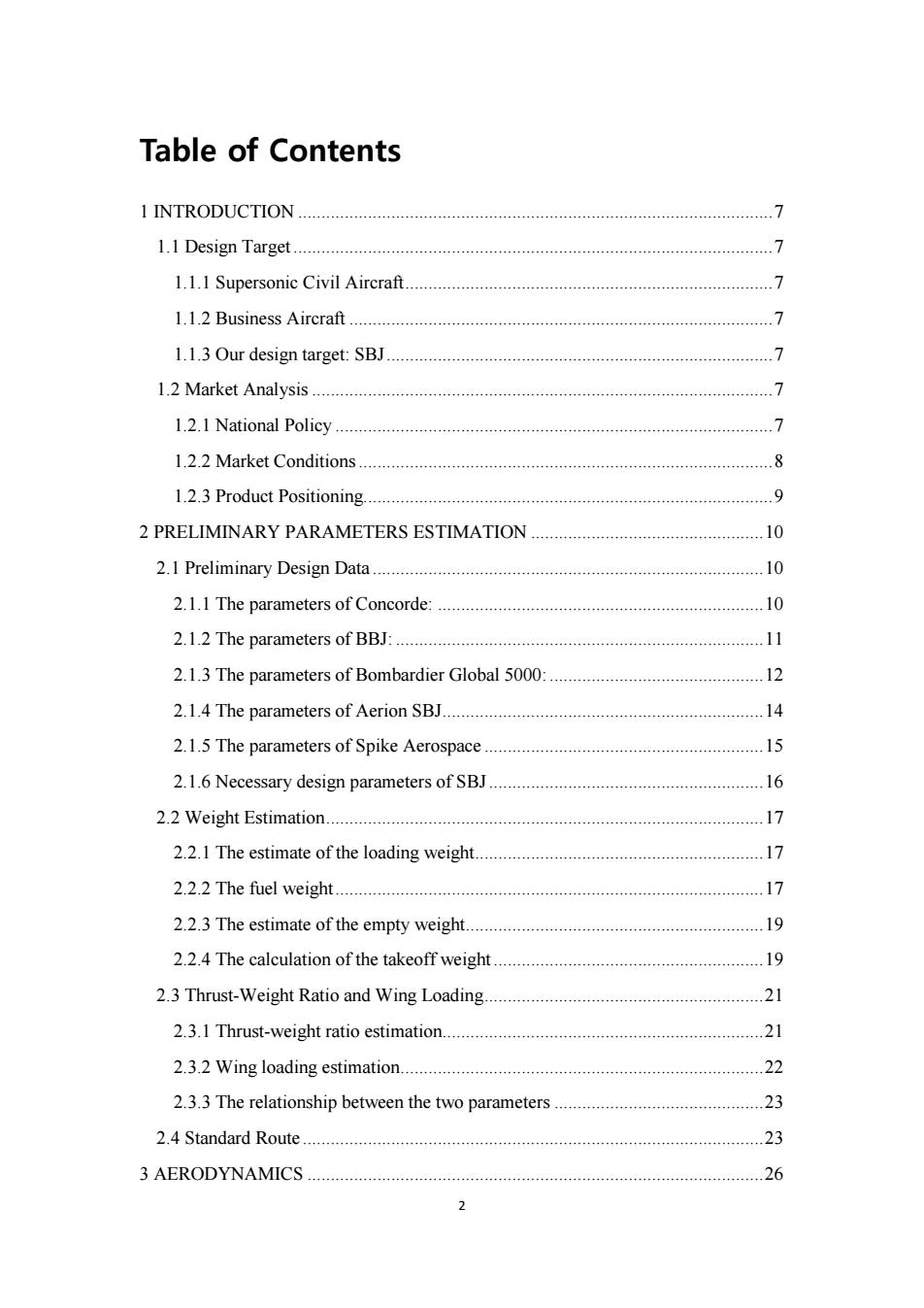
Table of Contents 1 INTRODUCTION........ 7 1.1 Design Target.......... .7 1.1.1 Supersonic Civil Aircraft.. 1.1.2 Business Aircraft......... 7 1.1.3 Our design target:SBJ.... 7 . 1.2 Market Analysis.............. 1.2.1National policy 7 1.2.2 Market Conditions....... 8 1.2.3 Product Positioning.......... .9 2 PRELIMINARY PARAMETERS ESTIMATION 10 2.1 Preliminary Design Data................. 10 2.1.1 The parameters of Concorde:............ 10 2.1.2 The parameters of BBJ: 11 2.1.3 The parameters of Bombardier Global 5000:.... .12 2.1.4 The parameters of Aerion SBJ.............. 14 2.1.5 The parameters of Spike Aerospace... 15 2.1.6 Necessary design parameters of SBJ 16 2.2 Weight Estimation............... 17 2.2.1 The estimate of the loading weight..... .17 2.2.2 The fuel weight... 17 2.2.3 The estimate of the empty weight 19 2.2.4 The calculation of the takeoff weight. 19 2.3 Thrust-Weight Ratio and Wing Loading. 21 2.3.1 Thrust-weight ratio estimation................ .21 2.3.2 Wing loading estimation...... 22 2.3.3 The relationship between the two parameters 23 2.4 Standard Route.... 23 3 AERODYNAMICS............. .26
2 Table of Contents 1 INTRODUCTION ......................................................................................................7 1.1 Design Target .......................................................................................................7 1.1.1 Supersonic Civil Aircraft...............................................................................7 1.1.2 Business Aircraft ...........................................................................................7 1.1.3 Our design target: SBJ...................................................................................7 1.2 Market Analysis ...................................................................................................7 1.2.1 National Policy ..............................................................................................7 1.2.2 Market Conditions.........................................................................................8 1.2.3 Product Positioning........................................................................................9 2 PRELIMINARY PARAMETERS ESTIMATION ..................................................10 2.1 Preliminary Design Data ....................................................................................10 2.1.1 The parameters of Concorde: ......................................................................10 2.1.2 The parameters of BBJ: ...............................................................................11 2.1.3 The parameters of Bombardier Global 5000:..............................................12 2.1.4 The parameters of Aerion SBJ.....................................................................14 2.1.5 The parameters of Spike Aerospace ............................................................15 2.1.6 Necessary design parameters of SBJ...........................................................16 2.2 Weight Estimation..............................................................................................17 2.2.1 The estimate of the loading weight..............................................................17 2.2.2 The fuel weight............................................................................................17 2.2.3 The estimate of the empty weight................................................................19 2.2.4 The calculation of the takeoff weight ..........................................................19 2.3 Thrust-Weight Ratio and Wing Loading............................................................21 2.3.1 Thrust-weight ratio estimation.....................................................................21 2.3.2 Wing loading estimation..............................................................................22 2.3.3 The relationship between the two parameters .............................................23 2.4 Standard Route ...................................................................................................23 3 AERODYNAMICS ..................................................................................................26

3.1 Foreword....... 26 3.1.1 Noise. 26 3.1.2Drag… 26 3.2 Fuselage.… 26 3.3 Nose... 27 3.4Wing.… 28 3.4.1 Wing platform design 28 3.4.2 Airfoil .30 3.5 Tails.. 31 3.5.1 Horizontal tail. 31 3.5.2 Vertical tail. 31 3.6 Engine Position… .. 32 3.7 Area Rule Design.… 32 3.8 Aerodynamics Force Calculation. 34 3.8.1 Low speed characteristics.... 34 3.8.2 High speed characteristics. 37 4 STRUCTURAL DESIGN.................. 40 4.1 Structural Load................ 40 4.1.1 Main load.… 40 4.1.2 Typical flight attitude and loading coefficient 40 4.1.3 Complex loading situation..... 42 4.2 Structural Criteria.... 44 4.2.1 Common Criteria.............. 44 4.2.2 Peculiar Criteria. 45 4.2.3 Environmental Conditions. 45 5 REFINED WEIGHT..... 46 5.1 Fuselage group 46 5.2 Wing group. 46 5.3 Tail Group.… 47 5.4 Power plant....... 47
3 3.1 Foreword ............................................................................................................26 3.1.1 Noise............................................................................................................26 3.1.2 Drag .............................................................................................................26 3.2 Fuselage..............................................................................................................26 3.3 Nose....................................................................................................................27 3.4 Wing...................................................................................................................28 3.4.1 Wing platform design. .................................................................................28 3.4.2 Airfoil ..........................................................................................................30 3.5 Tails....................................................................................................................31 3.5.1 Horizontal tail..............................................................................................31 3.5.2 Vertical tail ..................................................................................................31 3.6 Engine Position ..................................................................................................32 3.7 Area Rule Design ...............................................................................................32 3.8 Aerodynamics Force Calculation.......................................................................34 3.8.1 Low speed characteristics............................................................................34 3.8.2 High speed characteristics. ..........................................................................37 4 STRUCTURAL DESIGN.........................................................................................40 4.1 Structural Load...................................................................................................40 4.1.1 Main load.....................................................................................................40 4.1.2 Typical flight attitude and loading coefficient ............................................40 4.1.3 Complex loading situation...........................................................................42 4.2 Structural Criteria...............................................................................................44 4.2.1 Common Criteria .........................................................................................44 4.2.2 Peculiar Criteria...........................................................................................45 4.2.3 Environmental Conditions...........................................................................45 5 REFINED WEIGHT.................................................................................................46 5.1 Fuselage group ...................................................................................................46 5.2 Wing group.........................................................................................................46 5.3 Tail Group ..........................................................................................................47 5.4 Power plant.........................................................................................................47
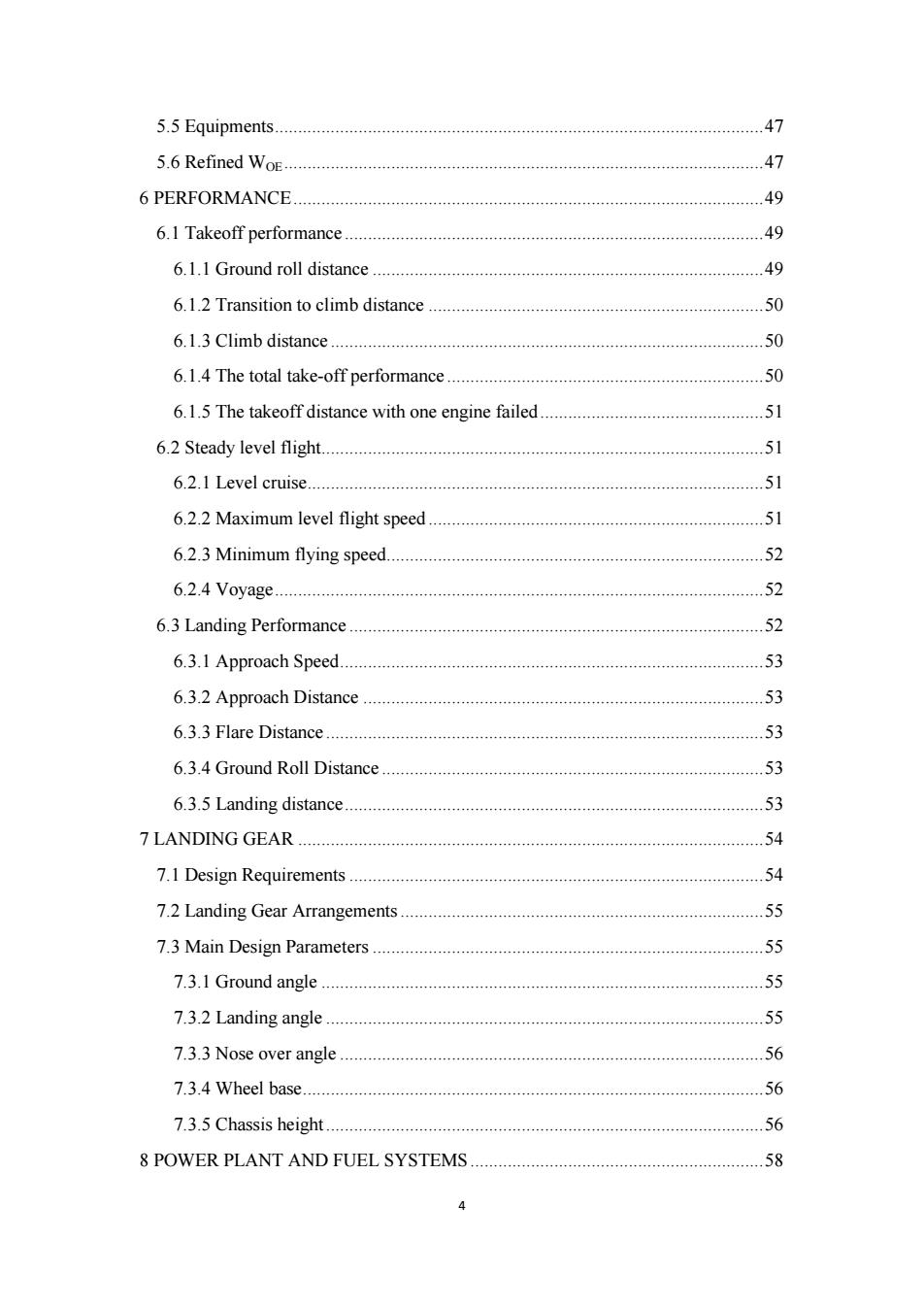
5.5 Equipments. 47 5.6 Refined Wo...... 47 6 PERFORMANCE............ 49 6.1 Takeoff performance.... 49 6.1.1 Ground roll distance...... 49 6.1.2 Transition to climb distance.... .50 6.1.3 Climb distance. 50 6.1.4 The total take-off performance................... .50 6.1.5 The takeoff distance with one engine failed......................................... .51 6.2 Steady level flight.. 51 6.2.1 Level cruise.. 51 6.2.2 Maximum level flight speed. 51 6.2.3 Minimum flying speed. 52 6.2.4 Voyage..… 52 6.3 Landing Performance.... 52 6.3.1 Approach Speed. 53 6.3.2 Approach Distance.... .53 6.3.3 Flare Distance......... 53 6.3.4 Ground Roll Distance.. .53 6.3.5 Landing distance........ 53 7LANDING GEAR.............. .54 7.1 Design Requirements......... 54 7.2 Landing Gear Arrangements 55 7.3 Main Design Parameters. 55 7.3.1 Ground angle 55 7.3.2 Landing angle 55 7.3.3 Nose over angle… 56 7.3.4 Wheel base...... 56 7.3.5 Chassis height......... 56 8 POWER PLANT AND FUEL SYSTEMS .58
4 5.5 Equipments.........................................................................................................47 5.6 Refined WOE.......................................................................................................47 6 PERFORMANCE.....................................................................................................49 6.1 Takeoff performance ..........................................................................................49 6.1.1 Ground roll distance ....................................................................................49 6.1.2 Transition to climb distance ........................................................................50 6.1.3 Climb distance .............................................................................................50 6.1.4 The total take-off performance ....................................................................50 6.1.5 The takeoff distance with one engine failed................................................51 6.2 Steady level flight...............................................................................................51 6.2.1 Level cruise..................................................................................................51 6.2.2 Maximum level flight speed ........................................................................51 6.2.3 Minimum flying speed.................................................................................52 6.2.4 Voyage.........................................................................................................52 6.3 Landing Performance .........................................................................................52 6.3.1 Approach Speed...........................................................................................53 6.3.2 Approach Distance ......................................................................................53 6.3.3 Flare Distance ..............................................................................................53 6.3.4 Ground Roll Distance ..................................................................................53 6.3.5 Landing distance..........................................................................................53 7 LANDING GEAR ....................................................................................................54 7.1 Design Requirements .........................................................................................54 7.2 Landing Gear Arrangements..............................................................................55 7.3 Main Design Parameters ....................................................................................55 7.3.1 Ground angle ...............................................................................................55 7.3.2 Landing angle ..............................................................................................55 7.3.3 Nose over angle ...........................................................................................56 7.3.4 Wheel base...................................................................................................56 7.3.5 Chassis height..............................................................................................56 8 POWER PLANT AND FUEL SYSTEMS...............................................................58
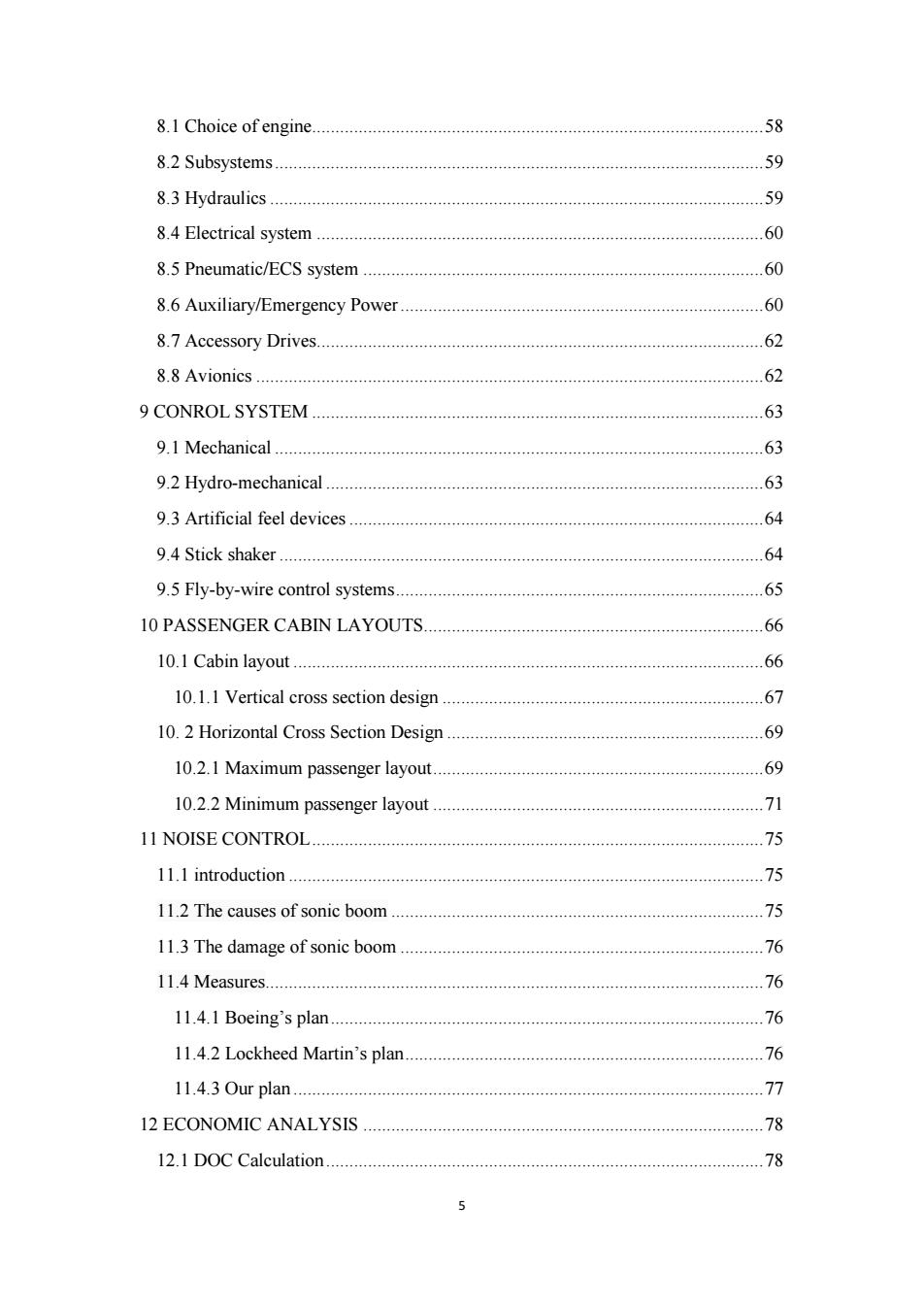
8.1 Choice of engine. 58 8.2 Subsystems. 59 8.3 Hydraulics.… 59 8.4 Electrical system 60 8.5 Pneumatic/ECS system 60 8.6 Auxiliary/Emergency Power .60 8.7 Accessory Drives......... 62 8.8 Avionics.… 62 9 CONROL SYSTEM 63 9.1 Mechanical........... 63 9.2 Hydro-mechanical.............. 63 9.3 Artificial feel devices............. 64 9.4 Stick shaker........... 64 9.5 Fly-by-wire control systems. 65 10 PASSENGER CABIN LAYOUTS 66 10.1 Cabin layout............ 66 10.1.1 Vertical cross section design... 67 10.2 Horizontal Cross Section Design.... 69 10.2.1 Maximum passenger layout.... 69 10.2.2 Minimum passenger layout..... 71 11 NOISE CONTROL............... .75 11.1 introduction......... 75 11.2 The causes of sonic boom............ 75 11.3 The damage of sonic boom. 76 11.4 Measures.… 76 11.4.1 Boeing's plan 76 11.4.2 Lockheed Martin's plan 76 11.4.3 Our plan.… 77 12 ECONOMIC ANALYSIS 78 12.1 DOC Calculation... .78
5 8.1 Choice of engine.................................................................................................58 8.2 Subsystems.........................................................................................................59 8.3 Hydraulics ..........................................................................................................59 8.4 Electrical system ................................................................................................60 8.5 Pneumatic/ECS system ......................................................................................60 8.6 Auxiliary/Emergency Power..............................................................................60 8.7 Accessory Drives................................................................................................62 8.8 Avionics .............................................................................................................62 9 CONROL SYSTEM .................................................................................................63 9.1 Mechanical .........................................................................................................63 9.2 Hydro-mechanical ..............................................................................................63 9.3 Artificial feel devices.........................................................................................64 9.4 Stick shaker ........................................................................................................64 9.5 Fly-by-wire control systems...............................................................................65 10 PASSENGER CABIN LAYOUTS.........................................................................66 10.1 Cabin layout .....................................................................................................66 10.1.1 Vertical cross section design .....................................................................67 10. 2 Horizontal Cross Section Design ....................................................................69 10.2.1 Maximum passenger layout.......................................................................69 10.2.2 Minimum passenger layout .......................................................................71 11 NOISE CONTROL.................................................................................................75 11.1 introduction ......................................................................................................75 11.2 The causes of sonic boom ................................................................................75 11.3 The damage of sonic boom ..............................................................................76 11.4 Measures...........................................................................................................76 11.4.1 Boeing’s plan.............................................................................................76 11.4.2 Lockheed Martin’s plan.............................................................................76 11.4.3 Our plan .....................................................................................................77 12 ECONOMIC ANALYSIS ......................................................................................78 12.1 DOC Calculation..............................................................................................78
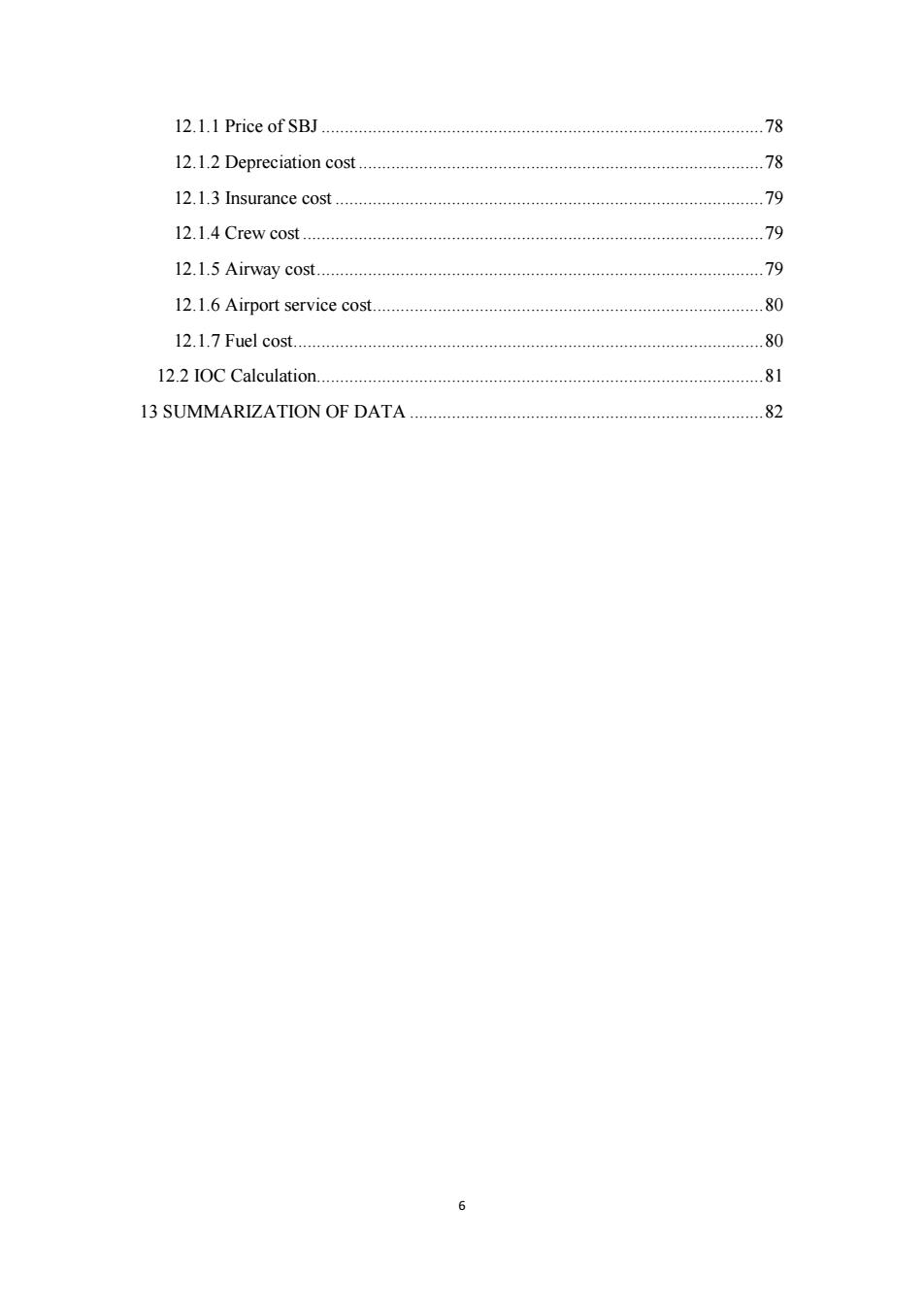
12.1.1 Price of SBJ 78 12.1.2 Depreciation cost 78 12.1.3 Insurance cost.......... 79 12.1.4 Crew cost........ .79 12.1.5 Airway cost..... .79 12.1.6 Airport service cost.......... 80 12.1.7Fuel cost... 80 81 13 SUMMARIZATION OF DATA.82
6 12.1.1 Price of SBJ...............................................................................................78 12.1.2 Depreciation cost .......................................................................................78 12.1.3 Insurance cost ............................................................................................79 12.1.4 Crew cost ...................................................................................................79 12.1.5 Airway cost................................................................................................79 12.1.6 Airport service cost....................................................................................80 12.1.7 Fuel cost.....................................................................................................80 12.2 IOC Calculation................................................................................................81 13 SUMMARIZATION OF DATA ............................................................................82
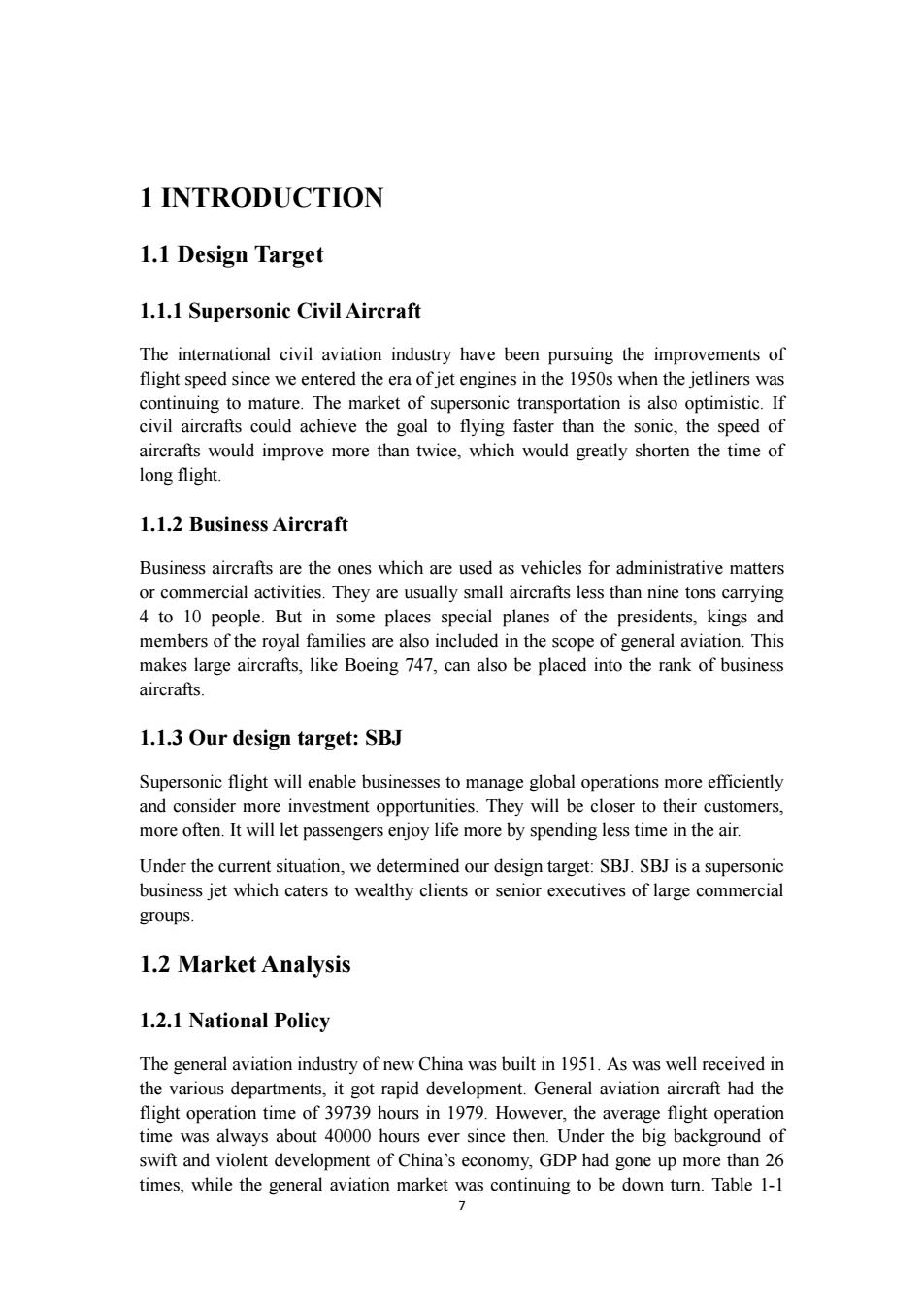
1 INTRODUCTION 1.1 Design Target 1.1.1 Supersonic Civil Aircraft The international civil aviation industry have been pursuing the improvements of flight speed since we entered the era of jet engines in the 1950s when the jetliners was continuing to mature.The market of supersonic transportation is also optimistic.If civil aircrafts could achieve the goal to flying faster than the sonic,the speed of aircrafts would improve more than twice,which would greatly shorten the time of long flight. 1.1.2 Business Aircraft Business aircrafts are the ones which are used as vehicles for administrative matters or commercial activities.They are usually small aircrafts less than nine tons carrying 4 to 10 people.But in some places special planes of the presidents,kings and members of the royal families are also included in the scope of general aviation.This makes large aircrafts,like Boeing 747,can also be placed into the rank of business aircrafts. 1.1.3 Our design target:SBJ Supersonic flight will enable businesses to manage global operations more efficiently and consider more investment opportunities.They will be closer to their customers, more often.It will let passengers enjoy life more by spending less time in the air. Under the current situation,we determined our design target:SBJ.SBJ is a supersonic business jet which caters to wealthy clients or senior executives of large commercial groups. 1.2 Market Analysis 1.2.1 National Policy The general aviation industry of new China was built in 1951.As was well received in the various departments,it got rapid development.General aviation aircraft had the flight operation time of 39739 hours in 1979.However,the average flight operation time was always about 40000 hours ever since then.Under the big background of swift and violent development of China's economy,GDP had gone up more than 26 times,while the general aviation market was continuing to be down turn.Table 1-1
7 1 INTRODUCTION 1.1 Design Target 1.1.1 Supersonic Civil Aircraft The international civil aviation industry have been pursuing the improvements of flight speed since we entered the era of jet engines in the 1950s when the jetliners was continuing to mature. The market of supersonic transportation is also optimistic. If civil aircrafts could achieve the goal to flying faster than the sonic, the speed of aircrafts would improve more than twice, which would greatly shorten the time of long flight. 1.1.2 Business Aircraft Business aircrafts are the ones which are used as vehicles for administrative matters or commercial activities. They are usually small aircrafts less than nine tons carrying 4 to 10 people. But in some places special planes of the presidents, kings and members of the royal families are also included in the scope of general aviation. This makes large aircrafts, like Boeing 747, can also be placed into the rank of business aircrafts. 1.1.3 Our design target: SBJ Supersonic flight will enable businesses to manage global operations more efficiently and consider more investment opportunities. They will be closer to their customers, more often. It will let passengers enjoy life more by spending less time in the air. Under the current situation, we determined our design target: SBJ. SBJ is a supersonic business jet which caters to wealthy clients or senior executives of large commercial groups. 1.2 Market Analysis 1.2.1 National Policy The general aviation industry of new China was built in 1951. As was well received in the various departments, it got rapid development. General aviation aircraft had the flight operation time of 39739 hours in 1979. However, the average flight operation time was always about 40000 hours ever since then. Under the big background of swift and violent development of China’s economy, GDP had gone up more than 26 times, while the general aviation market was continuing to be down turn. Table 1-1

shows the awkward situation. 年度 小时 年度 小时 年度 小时 1979 39739 1986 44022 1993 32387 1980 42792 1987 45749 1994 30743 1981 38869 1988 38268 1995 39485 1982 38544 1989 34452 1996 43071 1983 42804 1990 42524 1997 40877 1984 47303 1991 49016 1998 42962 1985 43022 1992 43985 Table 1-1:China general aviation flying operations (1979-1998) Things began to change since 2003.The new"Rules of general aviation flight control" came into force,which shortened the time of examination and approval and simplified the approval process.The low altitude opens policy was also going to be taken into practice Low and opening up,China's general aviation operations amount to an annual rate of about 15%of steady growth.In 2010,the government issued "Reform Suggestions of Deepen the low-altitude airspace management system".Low level of opening up has proceeded in an orderly way since then.It is reported that the national aviation authority proposes that China will have more than 2000 general airports before 2030. Besides the airports that we already have,1600 general airports will be constructed throughout the country over the next 15 years. With the publication of low altitude opens policy,general aviation welcomes a new development. 1.2.2 Market Conditions With the development of information technology and transportation industry, executive stuff of international enterprises often shut from country to country and continent to continent.However,they must waste time checking in as same as other leisure tourists because of the rigid arrangement of airline industry,which makes business jet more popular.Sales worldwide of private or business planes rose 35%in the first half of 2006 to a record $9 billion. Concorde was retired in 2003 due to a general downturn in the aviation industry after the type's only crash in 2000,the 11 September terrorist attacks in 2001 to discontinue maintenance support.But faster is always what human want and a supersonic business jet can effectively meet the demand of executive stuff of international enterprises or even national leaders. The major customers of business aircrafts,especially private aircrafts,are still famous entertainers and successful businessmen.International superstar Jackie Chan's private
8 shows the awkward situation. Table 1-1: China general aviation flying operations (1979-1998) Things began to change since 2003. The new “Rules of general aviation flight control” came into force, which shortened the time of examination and approval and simplified the approval process. The low altitude opens policy was also going to be taken into practice. Low and opening up, China’s general aviation operations amount to an annual rate of about 15% of steady growth. In 2010, the government issued “Reform Suggestions of Deepen the low-altitude airspace management system”. Low level of opening up has proceeded in an orderly way since then. It is reported that the national aviation authority proposes that China will have more than 2000 general airports before 2030. Besides the airports that we already have, 1600 general airports will be constructed throughout the country over the next 15 years. With the publication of low altitude opens policy, general aviation welcomes a new development. 1.2.2 Market Conditions With the development of information technology and transportation industry, executive stuff of international enterprises often shut from country to country and continent to continent. However, they must waste time checking in as same as other leisure tourists because of the rigid arrangement of airline industry, which makes business jet more popular. Sales worldwide of private or business planes rose 35% in the first half of 2006 to a record $9 billion. Concorde was retired in 2003 due to a general downturn in the aviation industry after the type's only crash in 2000, the 11 September terrorist attacks in 2001 to discontinue maintenance support. But faster is always what human want and a supersonic business jet can effectively meet the demand of executive stuff of international enterprises or even national leaders. The major customers of business aircrafts, especially private aircrafts, are still famous entertainers and successful businessmen. International superstar Jackie Chan’s private
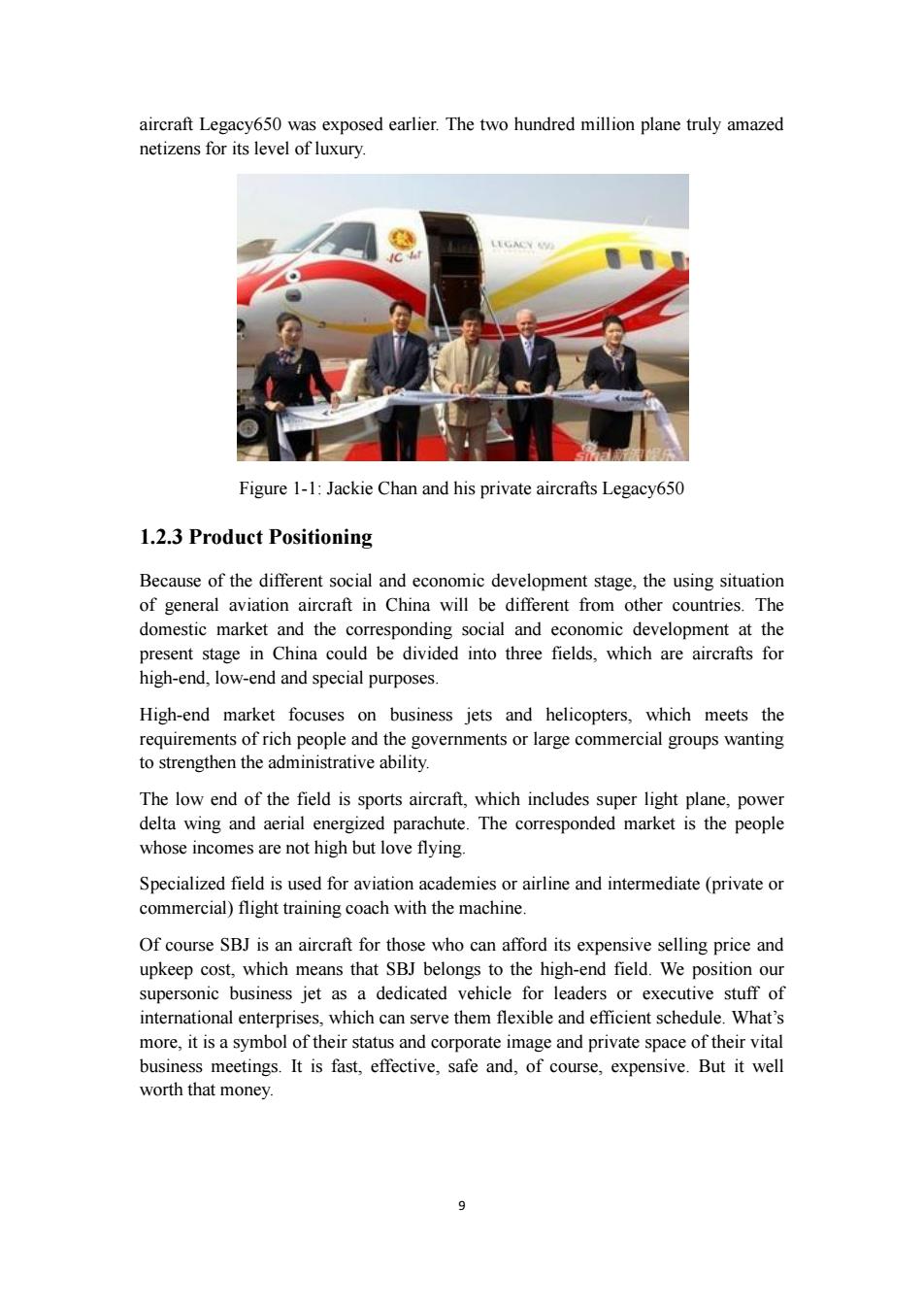
aircraft Legacy650 was exposed earlier.The two hundred million plane truly amazed netizens for its level of luxury. LUGACN W C4 Figure 1-1:Jackie Chan and his private aircrafts Legacy650 1.2.3 Product Positioning Because of the different social and economic development stage,the using situation of general aviation aircraft in China will be different from other countries.The domestic market and the corresponding social and economic development at the present stage in China could be divided into three fields,which are aircrafts for high-end,low-end and special purposes. High-end market focuses on business jets and helicopters,which meets the requirements of rich people and the governments or large commercial groups wanting to strengthen the administrative ability. The low end of the field is sports aircraft,which includes super light plane,power delta wing and aerial energized parachute.The corresponded market is the people whose incomes are not high but love flying Specialized field is used for aviation academies or airline and intermediate(private or commercial)flight training coach with the machine. Of course SBJ is an aircraft for those who can afford its expensive selling price and upkeep cost,which means that SBJ belongs to the high-end field.We position our supersonic business jet as a dedicated vehicle for leaders or executive stuff of international enterprises,which can serve them flexible and efficient schedule.What's more,it is a symbol of their status and corporate image and private space of their vital business meetings.It is fast,effective,safe and,of course,expensive.But it well worth that money. 9
9 aircraft Legacy650 was exposed earlier. The two hundred million plane truly amazed netizens for its level of luxury. Figure 1-1: Jackie Chan and his private aircrafts Legacy650 1.2.3 Product Positioning Because of the different social and economic development stage, the using situation of general aviation aircraft in China will be different from other countries. The domestic market and the corresponding social and economic development at the present stage in China could be divided into three fields, which are aircrafts for high-end, low-end and special purposes. High-end market focuses on business jets and helicopters, which meets the requirements of rich people and the governments or large commercial groups wanting to strengthen the administrative ability. The low end of the field is sports aircraft, which includes super light plane, power delta wing and aerial energized parachute. The corresponded market is the people whose incomes are not high but love flying. Specialized field is used for aviation academies or airline and intermediate (private or commercial) flight training coach with the machine. Of course SBJ is an aircraft for those who can afford its expensive selling price and upkeep cost, which means that SBJ belongs to the high-end field. We position our supersonic business jet as a dedicated vehicle for leaders or executive stuff of international enterprises, which can serve them flexible and efficient schedule. What’s more, it is a symbol of their status and corporate image and private space of their vital business meetings. It is fast, effective, safe and, of course, expensive. But it well worth that money

2 PRELIMINARY PARAMETERS ESTIMATION 2.1 Preliminary Design Data A supersonic business jet is a new aircraft design never seen before.What we can take for references are just Concorde,the only supersonic jet which was once put into commercial operation,and some successful subsonic business aircrafts produced by famous manufactures such as Boeing and Airbus. 2.1.1 The parameters of Concorde: As we all know,Concorde is the only one supersonic commercial aircraft which has been put into operation formally.Its parameters will enlighten us a lot during the design of SBJ. Figure 2-1:The Concorde GEOMETRY Length 62.10m Height 11.40m Wingspan 25.56m CABIN SIZE Length 39.32m Height 1.96m 10
10 2 PRELIMINARY PARAMETERS ESTIMATION 2.1 Preliminary Design Data A supersonic business jet is a new aircraft design never seen before. What we can take for references are just Concorde, the only supersonic jet which was once put into commercial operation, and some successful subsonic business aircrafts produced by famous manufactures such as Boeing and Airbus. 2.1.1 The parameters of Concorde: As we all know, Concorde is the only one supersonic commercial aircraft which has been put into operation formally. Its parameters will enlighten us a lot during the design of SBJ. Figure 2-1: The Concorde GEOMETRY Length 62.10 m Height 11.40 m Wingspan 25.56 m CABIN SIZE Length 39.32 m Height 1.96 m